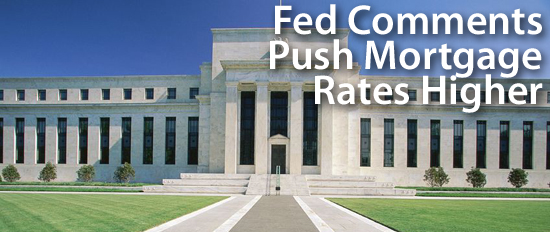Mortgage Rates Unexpectedly Rise After The Federal Reserve Releases Its October Fed Minutes
Mortgage rates and markets change constantly. Stay 100% current by taking The Mortgage Reports by email each day. Click here to get free email alerts, or subscribe to the RSS feed in your browser.

Mortgage rates unexpectedly rose Wednesday afternoon.
Reeling from the release of the October Fed Minutes, 30-year fixed rate mortgage rates climbed 0.125 percentage points, and 15-year fixed rate mortgage rates did the same. The Fed may not be closer to the end of QE3, but Wall Street is betting that it is.
Shopping for a mortgage rate? Consider locking something in. The longer you wait, the higher rates may go.
Click to see today's updated mortgage rates.
QE3 May End In Spring 2014; Mortgage Rates To Rise Sooner
Eight times annually, the Federal Reserve meets to discuss monetary policy. Three weeks after each meeting, the group releases minutes from the meeting. The minutes are an in-depth review of the conversations and debates which help to shape our nation's monetary policy.
The minutes are a complement to the Fed's more well-known, post-meeting press statement, which is far more concise. The latter can be measured in paragraphs; the former by pages. The Fed Minutes and its extra details are the closest that any of us get to "being in the room" when the Federal Reserve meets.
Some of the Fed's discussions are a retread. Some are a shift in thinking. October's minutes were a little bit of both.
The Fed remains cautious regarding economic growth, believing that more data is required before conclusions can be drawn; and housing was singled out again for its strength. Some participants expressed concern that rising mortgage rates may harm home affordability.
Rising mortgage rates have yet to have an adverse effect of housing, however, and several Fed members referenced the Senior Loan Officer Survey which showed the banks are gradually loosening credit requirements in order to approve more home loans.
The Fed is wary of mortgage rates rising too high, however, and spent a fair amount of time discussing QE3, the group's stimulus program which suppresses U.S. mortgage rates.
The Federal Reserves knows that QE3 can't last forever. It remain unsure, however, of how to best unwind the program in an orderly manner. Move too quick, and mortgage rates surge. Move too slow, and risk inflation.
Wall Street thinks QE3 may end too quick. Rates are worse since the release of the Fed Minutes.
QE3 May End Spring 2014; Mortgage Rates To Rise Sooner
Federal Reserve members also discussed inflation and the U.S. labor market at its July meeting. These two topics are of particular consequence to the Fed because of the group's dual-mandate charter to maximize employment and maintain stable prices.
Inflation continues to beneath the Fed's two-percent target rate; and, low enough to cause concern. When inflation runs too low, it's known as deflation and deflation can be even worse for the economy as its price-raising counterpart.
In a deflationary environment, the cost of goods and services drop such that consumers don't spend money, knowing that "prices will be lower" if they just wait it out.
Deflation is often a self-fulfilling prophecy.
To decrease the likelihood of deflation, the Federal Reserve voted to keep the Fed Funds Rate in a range near zero percent after its last meeting because a low Fed Funds Rate is promotes rising prices.
The effects of Fed policy have been muted. Consumer prices rose just 1% since 12 months ago. This is the lowest annual rate of inflation since October 2009 -- the month which began last decade's recession.
Low inflation rates are one reason why QE3 is still around.
QE3 is shorthand for "Quantitative Easing, Round 3". It was first announced in September 2012 and was launched with no specific "end date". QE3 would last until it was no longer needed, the Fed said.
Via QE3, the Federal Reserve purchases $40 billion in mortgage-backed bonds monthly in the open market; and $45 billion in U.S. Treasury Notes. The purchases create additional demand for bonds which pushes prices higher and, by association, pushes yields lower.
Not surprisingly, within 10 weeks of QE3's start, U.S. mortgage rates had dropped to their lowest levels in history. Home buyers benefitted from record-high affordability and refinancing households piled into refi programs including HARP, the FHA Streamline Refinance and the VA IRRRL.
Now, as the Fed discusses the end of QE3, mortgage rates have reversed.
Fed member remain divided on the issue :
- Some want to use QE3 to raise the rate of inflation
- Some want to leave QE3 in place until the labor market shows "further improvement" and stability
- Some want the Fed to eliminate QE3 "in the near future".
Non-consensus for QE3 has Wall Street investors scrambling. QE3 will likely end soon, they think, but how soon? The Fed doesn't even know. Some members suggested a calendar date and others wish to remain data-dependent.
The word "uncertain" appeared 7 times in the FOMC text.
Should You Lock Your Mortgage Rate?
The next Federal Reserve meeting is scheduled for December 17-18, 2013. The Fed is not expected to add new market stimulus at that time, nor is it expected to reduce or remove the stimulus which already exists (and this includes QE3). Mortgage rates will continue to be volatile in the meanwhile, however.
It's all eyes on QE3. The longer the program lasts, the longer that mortgage rates will remain suppressed. Time may be running out. Get today's mortgage rates now. You can get them online. The steps are fast, free, and there's no obligation whatsoever..